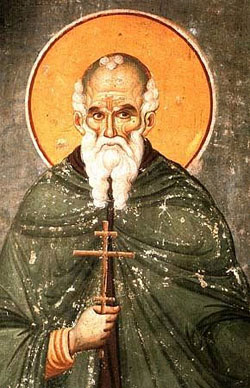
Feastday: July 5
Birth: 920
Death: 1000
Abbot and founder. He was born in Trebizond, Turkey, and studied at Constantinople. There he became a monk, going to St. Michael's Monastery in Kymina, Bithynia to join a laura. To avoid being named abbot of St. Michael's, Athanasius went to Mount Athos in Greece, where he aided Nicephoras Phocas, a longtime friend, in repelling the Saracens who were invading the region. Successful in this military campaign, Athanasius received financial backing from his friend to found a monastery on Mount Athos in 961. When Phocas became emperor, Athanasius went to Cyprus to avoid being called to court, but Phocas sent word to him that he should return to his monastery In establishing the laura system, Athanasius made enemies of the monks already on the mount. Only imperial protection kept him safe from assassination at tempts. In time, he served as abbot of fifty-eight communities of monks and hermits on Mount Athos. He and five monks were killed when the arch of a church collapsed.
Athanasius the Athonite (c. 920 – c. 1003; Greek: Ἀθανάσιος ὁ Ἀθωνίτης), also called Athanasios of Trebizond, was a Byzantine monk who founded the monastic community on Mount Athos, which has since evolved into the greatest centre of Eastern Orthodox monasticism.
Born in Trebizond and patronized by Michael Maleinos, he studied at Constantinople and became famous there as Abraham, a fervent preacher who held great authority with Michael's nephew, Nicephoros Phocas. By the time Phocas ascended the imperial throne, Abraham, ill at ease with the lax morals of the monks living in the capital, changed his name to Athanasios and joined the monks at Mount Kyminas in Bithynia. In 958, he relocated to Mount Athos.
He helped defend the hermits, or sketes, there against the Saracens, and also started to incorporate the sketes already there into what would eventually become known as the Great Lavra, which Athanasios built with the financial assistance of Nicephoros. This monastery was dedicated in 963. It is still in use today, and is often referred to by people of the area simply as "Lavra", or "The Monastery". Three other foundations followed shortly thereafter, with all three of them remaining in place to the present. Athanasios met with considerable opposition from the hermits already at Mount Athos in the construction of his monasteries. They resented his intrusion and his attempts to bring order and discipline to their lives.
Upon Nicephoros' death the enemies of Athanasios prevailed and he had to leave Athos for Cyprus, where he lived until the new emperor, John Tzimisces, resumed the patronage of the Great Lavra and bestowed upon the monastery its first charter in 971. Athanasios, spurred by a divine vision, returned at once to Athos as a hegumen (abbot) and introduced a typicon for cenobites, based on those compiled by Theodore Studites and Basil of Caesarea.
He died during an accident, killed by a falling masonry, when the cupola of his church collapsed. Upon his death, Athanasios was glorified as a saint. His feast day is July 5.

